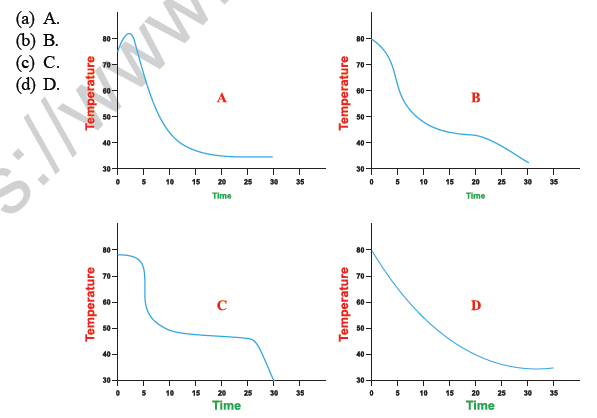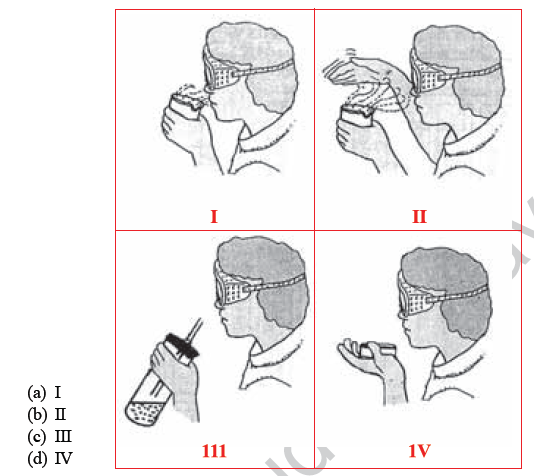SECTION A
Question. The correct order which describes the true solution, colloidal solution and suspension in the order of their increasing stability is :
(a) Suspension < colloidal solution < true solution
(b) Colloidal solution < true solution < suspension
(c) True solution < colloidal solution < suspension
(d) Colloidal solution < suspension < true solution
Question. To prepare iron sulphide, by heating a mixture of iron filings and sulphur powder, we should use a
(a) test tube.
(b) watch glass.
(c) china dish.
(d) petri dish.
Question. When a mixture of common salt and ammonium chloride is heated, it is observed that
(a) Solid common salt gets deposited on the cooler parts of the funnel while solid ammonium chloride remains in the china dish.
(b) Mixture of common salt and ammonium chloride turns into greenish crystals when allowed to cool.
(c) Ammonium chloride gets deposited on the cooler parts of the funnel and solid common salt remains in the china dish.
(d) droplets containing both common salt and ammonium chloride appear on the upper part of the funnel while some molten mixture of common salt and ammonium chloride remains in the china dish.
Question. Copper sulphate solution is added to a test tube containing a clean iron nail. The correct description regarding the deposition of copper on the iron nail would be that it starts depositing
(a) at the tip of the nail
(b) from the head of the nail
(c) in the middle of the nail
(d) anywhere on the nail
Question. While determining the density of a copper piece using a spring balance and a measuring cylinder, Seema carried out the following procedure :
i. noted the water level in the measuring cylinder without the copper piece
ii. immersed the copper piece in the water
iii. noted the water level in the measuring cylinder with the copper piece inside it.
iv. removed the copper piece from the water and immediately weighed it using a spring balance.
The wrong step in the procedure is
(a) step (i)
(b) step (ii)
(c) step (iii)
(d) step (iv)
Question. The temperature-time variation graphs, as obtained by four students A, B, C and D are as shown. The graph, likely to be correct is that of student.

Question. A laboratory had the following apparatus available in it :
(A) Two thin hollow wooden tubes
(B) An intense & broad source of sound
(C) An Intense, pointed source of sound
(D) A sharp pointed detector to detect the sound
(E) A well polished metal sheet
(F) A white painted thermocol sheet
A student can do his experiment to verify the laws of reflection of sound successfully by choosing the appartus labelled as
(a) A, C, D, E
(b) A, C, E
(c) A, B, D, E
(d) A, C & D
Question. While doing the experiment on measuring the velocity of a pulse through a stretched string, a student had to choose between a
(i) thick silk string and a thick cotton string
(ii) stop clock and a table clock.
The combination choice that he should prefer is
(a) silk string and the table clock
(b) silk string and the stop clock
(c) cotton string and the table clock
(d) cotton string and the stop clock
Question. On adding water to a sample of arhar dal (tuvar dal) a student found that the water became yellow in colour. He took a sample of this yellow water and added a few drops of dilute HCl. The sample became pink. This confirms that the adulterant added to the dal was
(a) Turmeric
(b) metanil yellow
(c) potassium dichromate
(d) yellow dye
Question. Given below are four operations for preparing a temporary mount of human cheek cells :
(i) taking scraping from inner side of the cheek and spreading it on a clean slide
(ii) putting a drop of gycerine on the material
(iii) adding two or three drops of methylene blue
(iv) rinsing the mouth with fresh water and disinfectant solution.
The correct sequence of these operations is
(a) i-ii-iii-iv
(b) iv-i-iii-ii
(c) iv-i-ii-iii
(d) i-iii-ii-iv
Question. The specimens of a bird and a fish were given to students to identify the feature / features that places them in the same phylum. The correct identifying feature /features would be
(a) pointed heads.
(b) bulky thorax.
(c) presence of scales.
(d) post anal tails.
Question. The figures below show set-ups for studying the reaction of zinc with sodium bydroxide.
The correct set-up is
(a) I.
(b) II.
(c) III.
(d) IV.
Question. Two beakers A and B contain Iron (II) sulphate solution. In the beaker A is placed a small piece of copper and in the beaker B is placed a small piece of zinc. It is found that a grey deposit forms on the zinc but not on the copper. From these observations it can be concluded.
(a) Zinc is most active metal followed by iron and copper.
(b) Zinc is most active metal followed by copper and then iron.
(c) Iron is most active metal followed by zinc and then copper.
(d) Iron is most active metal followed by copper and then zinc.
Question. The most appropriate method of testing the odour of a given liquid is

Question. In an experiment to determine the focal length of a convex lens, a student obtained a sharp inverted image of distant tree on the screen behind the lens. She then removed the screen and looked through the lens in the direction of the object. She will see
(a) an inverted image of the tree at the focus of the lens.
(b) no image as the screen has been removed.
(c) a blurred image on the wall of the laboratory.
(d) an erect image of the tree on the lens.
Question. In an experiment, to find the equivalent resistance of a series of combination of two resistors R1 and R2 a student uses the ciruit shown here.
The circuit will give
(a) correct reading for volage V, but incorrect reading for current I.
(b) correct reading for current I, but incorrect reading for voltage V.
(c) correct reading for both current I and voltage V.
(d) incorrect readings for both current I and voltage V.
Question. In an experimet to study dependence of current on the potential difference across a given resistor, four students P, Q, R and S kept the plug key in the circuit closed for time t1 and then open for time t2 as given in the table below.
The best choice of open and closed time is that of student
(a) P.
(b) Q.
(c) R.
(d) S.
Question. The following figures illustrate binary fission in Amoeba in an incorrect sequence.
The correct sequence is
(a) (i), (iii), (iv), (ii)
(b) (ii), (iii), (iv), (i)
(c) (iv), (iii), (ii), (i)
(d) (iii), (iv), (ii), (i)
Question. The following experiment is set up to show that a gas is released during respiration by germinating seeds.
In this set up, the small test tube containing KOH solution is kept in the conical flask to absorb
(a) air in the flask.
(b) moisture in the flask.
(c) O2 from the air in the flask.
(d) CO2 released by the germinating seeds.
Question. A leaf from a de-strached plant is covered with black paper strip as shown in figure 1. The starch test is done on the leaf after 8 hours.
The results will be as shown in diagram
(a) A.
(b) B.
(c) C.
(d) D.
SECTION B
Question. Which one of the following experimental arrangements is correct for the determination of boiling point of water?
(a) I.
(b) II.
(c) III.
(d) IV.
Question. Three students A, B and C determined the volume of a solid by immersing it in water in the overflow cans set up as shown. The result obtained will be wrong for
(a) student A.
(b) student B.
(c) student C.
(d) all three student.
Question. Four slides were observed under the microscope for spot test as shown below. The correct identification of the four spots is
Question. Figures of two plants are given below. Observe them carefully and select the option which correctly gives their identification and the names of groups to which they belong.
(a) A : moss; Bryophyta
B : Fern; Tracheophyta
(b) A : pine; Gymnospermae
B : leafy plant; Angiospermae
(c) Both A and B are liverworts and belong to Tracheophyta
(d) Both A and B are ferns and belong to Bryophyta.
Question. A student was given three samples containg ethanoic acid, sodium bicarbonate solution and water in test tubes I, II and III, respectively. On dipping a pH paper in them, he observed that the colour turned orange in I, blue in II and green in III. If arranged in inreasing order of their pH, the sequence of these bottles would be
(a) I, III, II.
(b) I, II, III.
(c) III, I, II.
(d) II, III, I.
Question. On heating ferrous sulphate crystals, one would get
(a) Sweet smell
(b) lotten egg smell
(c) irritating, choking smell
(d) none of the above
Question. In an experiment to trace the path of a ray of light passing through a rectangular glass slab,four students tabulated their observation as given below.
The student most likely to have done the experiment properly is
(a) A.
(b) B.
(c) C.
(d) D.
Question. For the circuits A and B shown below, the voltmeter readings would be
(a) 0.6 in circuit A and 2.5 V in circuit B.
(b) 0 V in both circuits.
(c) 5V in boh circuits.
(d) 0 V in circuit A and 3 V in circuit B.
Question. While performing an experiment with raisins, a student recorded the following data.
Mass of water taken in the beaker = 50 g
Mass of raisins before soaking = 20 g
Mass of raisins after soaking = 30 g
Mass of water in beaker left after experiment = 40 g
The % of water absorbed by the raisins is
(a) 10%
(b) 20 %
(C) 45 %
(d) 50 %
Question. Using the same number of given germinating gram seeds, two students A and B set up the experiment separately. Student A used a cotton plug to hold the bent tube in the mouth of the flask. Student B used a rubber cork.
After 4 hours they noticed that
(a) water level increased in the bent tube only of A.
(b) water level increased in the bent tube only of B.
(c) the cotton plug was wet.
(d) the water in the beaker of tube turned milky.

